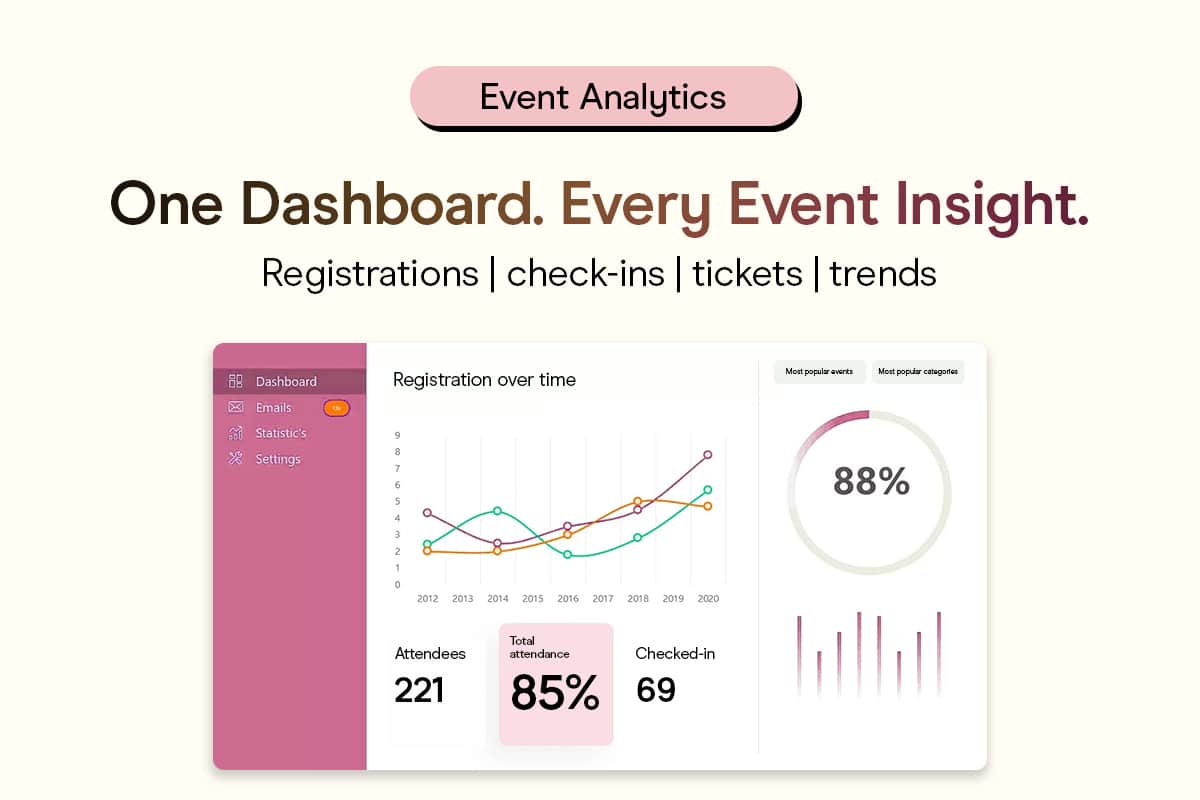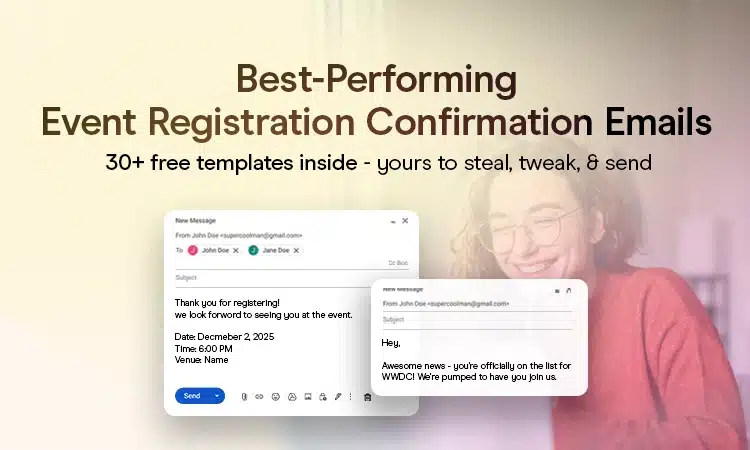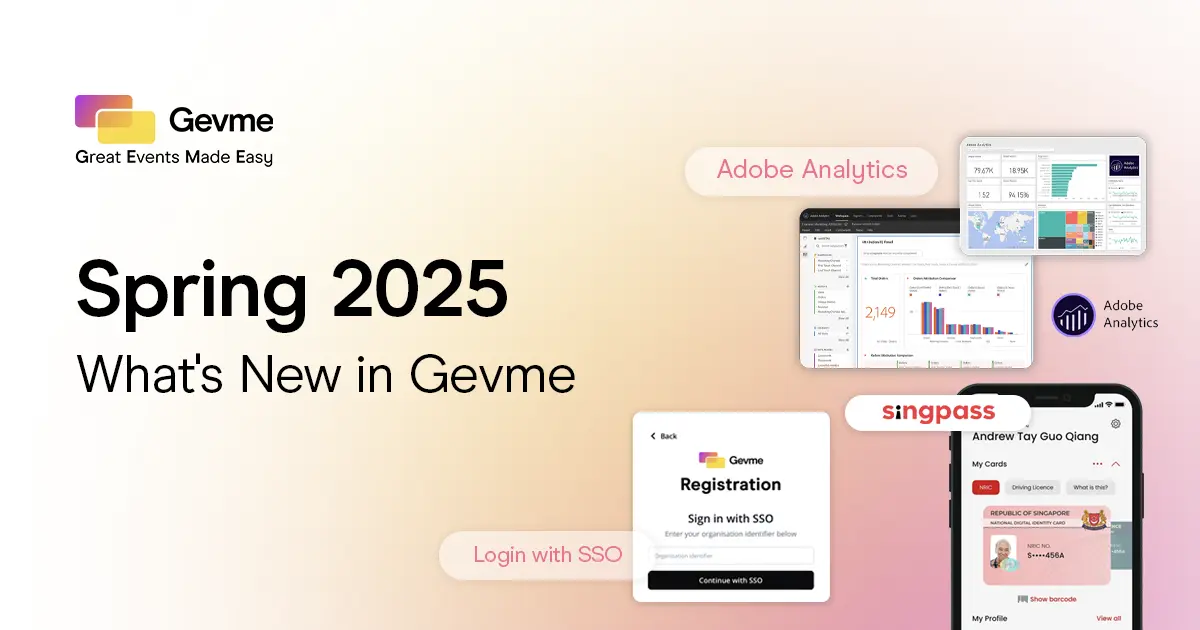A cumbersome registration process can deter potential attendees, leading to significant drop-off rates. Studies indicate that approximately 27% of individuals abandon online forms due to their length, and 10% exit because of unnecessary questions. This underscores the necessity for a streamlined and user-friendly event registration experience to maximize participation and engagement.
The Critical Role of Seamless Event Registration
The event registration experience serves as the initial interaction between organizers and prospective attendees, setting the tone for the entire event. A seamless event registration process not only facilitates higher sign-up rates but also reflects positively on the event’s overall professionalism. Conversely, a complicated or lengthy registration can lead to frustration and increased abandonment rates.
For instance, the global events industry is projected to grow to $2 trillion by 2028, with a compound annual growth rate (CAGR) of 11.1% from 2022 to 2028. This growth highlights the increasing importance of efficient registration systems to handle the rising number of events and attendees.
Moreover, mobile optimization plays a crucial role in enhancing the registration experience. Mobile-friendly registration pages offer a seamless experience for users on any device, reducing abandonment rates by making it easy for users to complete the registration process on-the-go.
By prioritizing a seamless event registration experience, organizers can enhance attendee satisfaction, increase participation rates, and set a positive precedent for the event itself.
Key Elements of an Effective Registration Experience
Creating a seamless event registration process is pivotal for maximizing attendee participation and satisfaction. By focusing on the following key components, event organizers can enhance the overall registration experience:
1. User-Friendly Interface
A user-friendly interface is vital for reducing form abandonment. Best practices include:
- Simplify the Form: Request only essential information to avoid overwhelming registrants.
- Clear Labels and Instructions: Ensure each field is clearly labeled with concise instructions to guide users through the process.
- Logical Flow: Organize fields in a logical sequence, grouping related information together to facilitate completion.
Implementing these practices can lead to a more streamlined and user-friendly registration experience.
2. Mobile Optimization
With a significant portion of users accessing registration forms via mobile devices, ensuring mobile responsiveness is crucial. A mobile-friendly registration page should:
- Responsive Design: Adapt seamlessly to various screen sizes and orientations.
- Touch-Friendly Elements: Incorporate easily tappable buttons and form fields suitable for touchscreens.
- Minimal Scrolling and Typing: Design forms that require minimal input and navigation to complete.
Optimizing for mobile ensures a smooth user experience and reduces registration friction.
3. Multiple Payment Options
Offering a variety of payment methods caters to diverse attendee preferences and can increase conversion rates. Incorporating options such as credit cards, digital wallets, and bank transfers ensures a seamless transaction process.
4. Automated Confirmations and Reminders
Immediate confirmation emails and timely reminders keep attendees informed and engaged. Automating these communications ensures consistency and reduces the administrative burden on event organizers.
By integrating these elements, event organizers can create a seamless registration experience that encourages higher participation and sets a positive tone for the event.
Common Pitfalls to Avoid in Event Registration
Ensuring a seamless event registration experience is crucial for maximizing attendee participation and satisfaction. However, certain common pitfalls can hinder this process. By recognizing and addressing these issues, event organizers can enhance the overall registration experience.
1. Overcomplicating the Registration Form
Lengthy or complex registration forms can deter potential attendees. To mitigate this:
- Simplify the Form: Request only essential information during the initial registration phase.
- Use Conditional Logic: Display questions based on previous answers to keep the form concise and relevant.
- Provide Clear Instructions: Ensure each field is accompanied by straightforward guidance to prevent confusion.
Implementing these strategies can lead to higher completion rates and a more user-friendly registration experience.
2. Neglecting Data Privacy and Security
Failing to prioritize data privacy can erode trust and deter registrations. Approximately 29% of users abandon forms due to concerns over data security. To address this:
- Transparent Data Policies: Clearly communicate what data is being collected and how it will be used.
- Obtain Explicit Consent: Include checkboxes for attendees to agree to data collection and usage policies.
- Implement Robust Security Measures: Use encryption and secure servers to protect personal information.
By demonstrating a commitment to data security, organizers can build trust and encourage more registrations.
3. Ignoring Technical Glitches
Technical issues during the registration process can frustrate users and lead to abandonment. Common problems include slow loading times, broken links, and payment processing errors. To prevent these:
- Regular Testing: Conduct thorough testing of the registration system across various devices and browsers.
- Monitor Performance: Use analytics tools to identify and address bottlenecks or drop-off points.
- Provide Support Channels: Offer immediate assistance through chat support or helplines to resolve issues promptly.
Proactively managing technical aspects ensures a smoother registration experience and reduces the likelihood of abandonment.
Leveraging Technology for Enhanced Registration
Integrating data analytics into the registration process provides valuable insights. Gevme’s reporting tools offer real-time data on attendee behavior, aiding in informed decision-making. Key technological enhancements include:
1. Customizable Registration Platforms
Utilizing platforms that offer customizable registration forms allows organizers to tailor the registration experience to the specific needs of their event and audience. Benefits include:
- Personalized Data Collection: Collect pertinent attendee information, such as dietary preferences or session choices, enhancing the overall event experience.
- Brand Consistency: Design registration pages that align with the event’s branding, providing a cohesive look and feel.
- Flexibility: Adapt forms for various ticket types, workshops, or breakout sessions, accommodating diverse attendee needs.
2. Data Analytics Integration
Incorporating data analytics into the registration process provides valuable insights into attendee behavior and event performance. Advantages include:
- Real-Time Monitoring: Track registration trends and adjust marketing strategies promptly to boost attendance.
- Informed Decision-Making: Analyze data to identify popular sessions or speakers, aiding in future event planning.
- Enhanced Engagement: Utilize attendee data to personalize communication and engagement strategies.
3. CRM and Email Marketing Integration
Integrating Customer Relationship Management (CRM) systems with email marketing platforms streamlines communication and enhances attendee relationships. Benefits include:
- Centralized Data Management: Maintain a unified database of attendee interactions, preferences, and history.
- Personalized Communication: Craft targeted email campaigns based on attendee data, increasing engagement and satisfaction.
- Efficient Follow-Ups: Automate post-event surveys and feedback requests, facilitating continuous improvement.
Real-World Example: Transforming Event Registration Efficiency
Implementing a seamless event registration process can significantly enhance attendee satisfaction and operational efficiency. A notable example is the collaboration between a leading architecture and event management firm and M2 Strategy during two major international sporting competitions—the Warrior Games and Invictus Games.
Case Study: Enhancing Event Management and Registration
Challenges:
- Complex Registration and Role-Based Access Control: Managing thousands of participants across multiple teams and categories required a centralized registration platform with real-time updates and structured data management. Different users, such as coaches, medical staff, and event organizers, needed distinct permission levels to manage their team’s information while ensuring data security and compliance.
- Integration for Multi-Purpose Event Functions: Beyond basic registration, the solution needed to integrate with security protocols, credentialing systems, competition scheduling, broadcasting, and result tracking. A lack of an automated system meant the risk of inconsistent data, delays, and inefficiencies in event execution.
- Scalability for Future Use: The firm required a repeatable and scalable solution that could be used across multiple event cycles and accommodate tens of thousands of participants while maintaining accuracy, efficiency, and a seamless user experience.
Solutions Implemented:
- Advanced Role-Based Registration System: M2 developed a secure, web-based registration platform powered by Smartsheet that allowed teams, contractors, and staff to easily register participants while ensuring role-based access control. Key features included custom user roles and permissions, automated data validation, and real-time updates and change tracking.
- Integrated Event Management & Data Synchronization: The platform integrated seamlessly with credentialing, security clearance, competition registration, and broadcasting systems, providing instant data synchronization, automated competition registration and scheduling, and results tracking integration.
- Scalable, Repeatable Solution for Future Events: M2 designed the solution to be scalable and reusable, enabling its adoption for future event cycles. The system now supports over 25,000 participants annually and continues to be a reliable, efficient, and adaptable event management tool.
Results Achieved:
- Streamlined Registration & Participant Management: Achieved an 80% reduction in manual data entry efforts, real-time participant updates, and seamless role-based access, enhancing security and data integrity.
- Increased Event Execution Efficiency: Realized a 50% faster credentialing and security clearance process through integrated data sharing, automated competition registration and scheduling, and enhanced broadcasting and results tracking, providing real-time data synchronization.
- Scalable and Sustainable Event Management: Successfully used across multiple international sporting events, scaled to support 25,000+ participants annually, and established a repeatable framework ensuring future event efficiency and reduced administrative workload.
This case study illustrates the impact of implementing a tailored, technology-driven registration system on event success.
Final Thoughts
A seamless event registration experience is pivotal in setting the tone for a successful event. By adopting these strategies, event professionals can ensure a smooth registration process, laying the foundation for a memorable and successful event.
Enhance your event’s success with Gevme’s comprehensive event registration solutions:
- Customizable Registration Forms: Tailor forms to your event’s specific needs.
- Mobile Optimization: Ensure a seamless experience across all devices.
- Integrated Payment Systems: Support multiple payment options for attendee convenience.
- Automated Communications: Keep attendees informed with instant confirmations and reminders.
- Data Analytics and Reporting: Gain valuable insights to optimize future events.
Experience the ease of managing your event registrations with Gevme.
Request a demo today.








